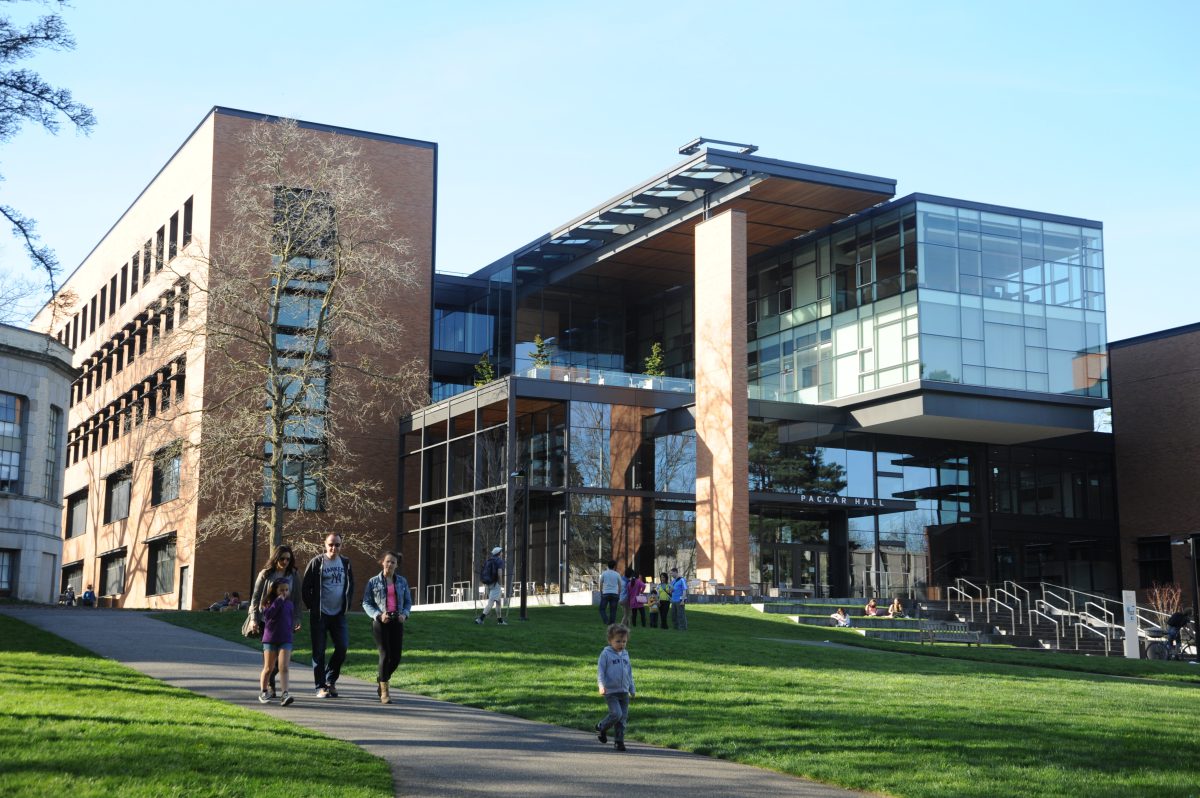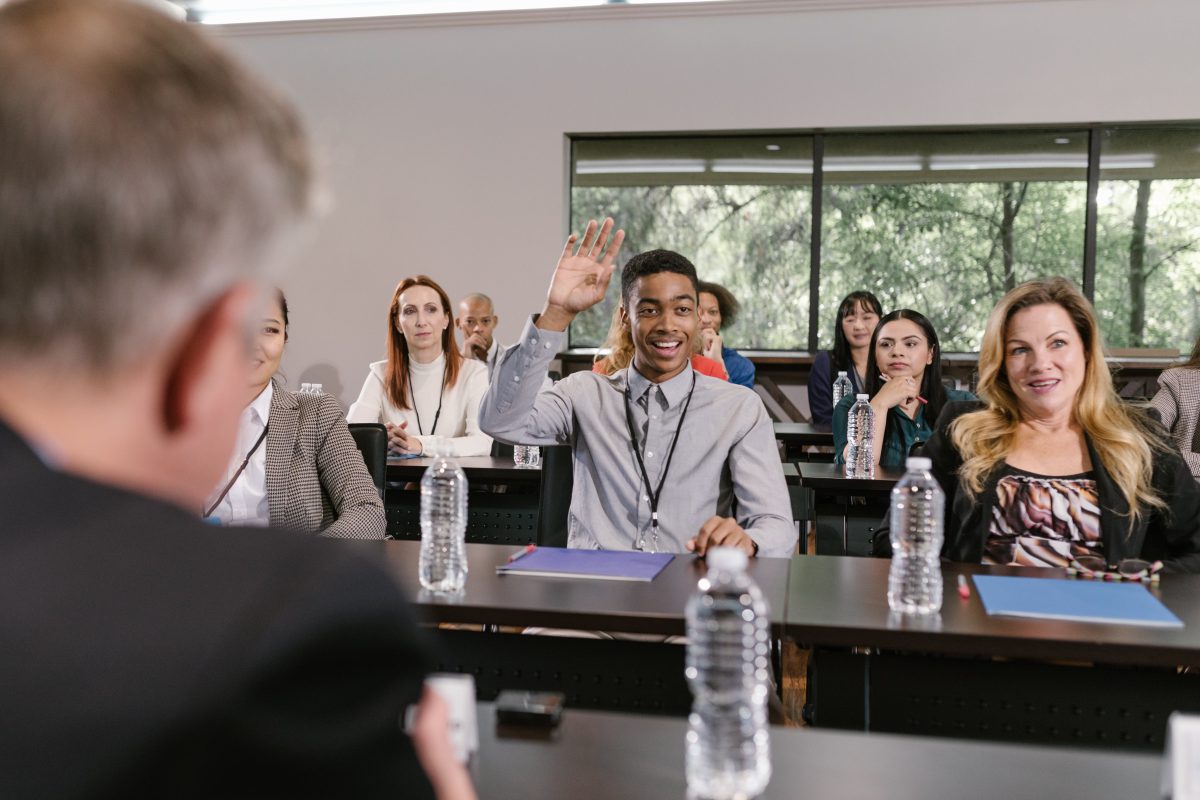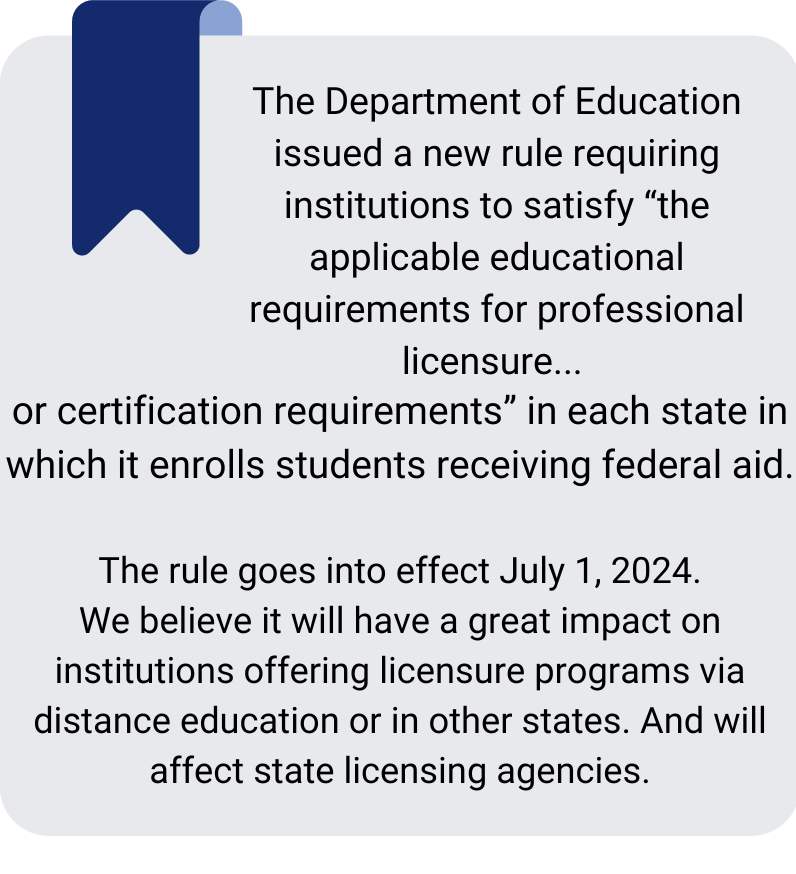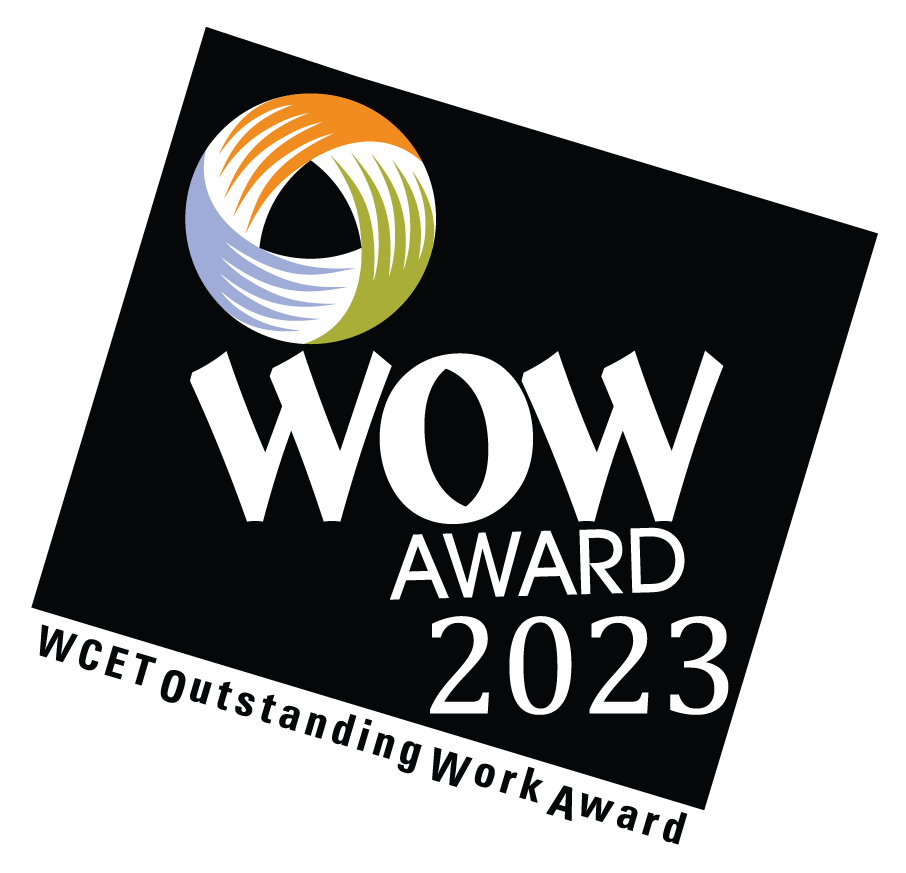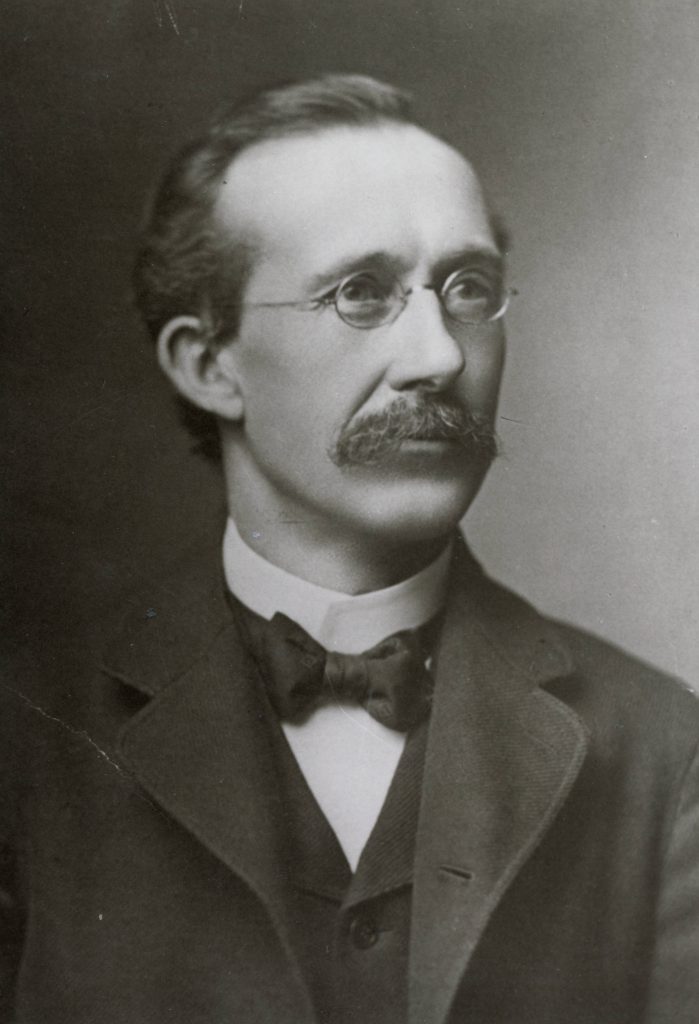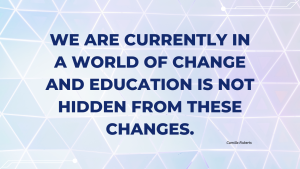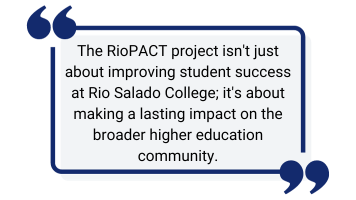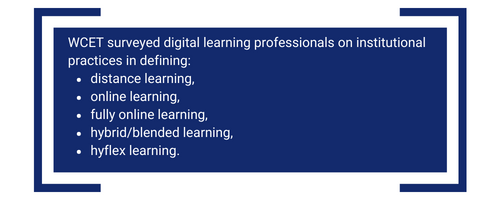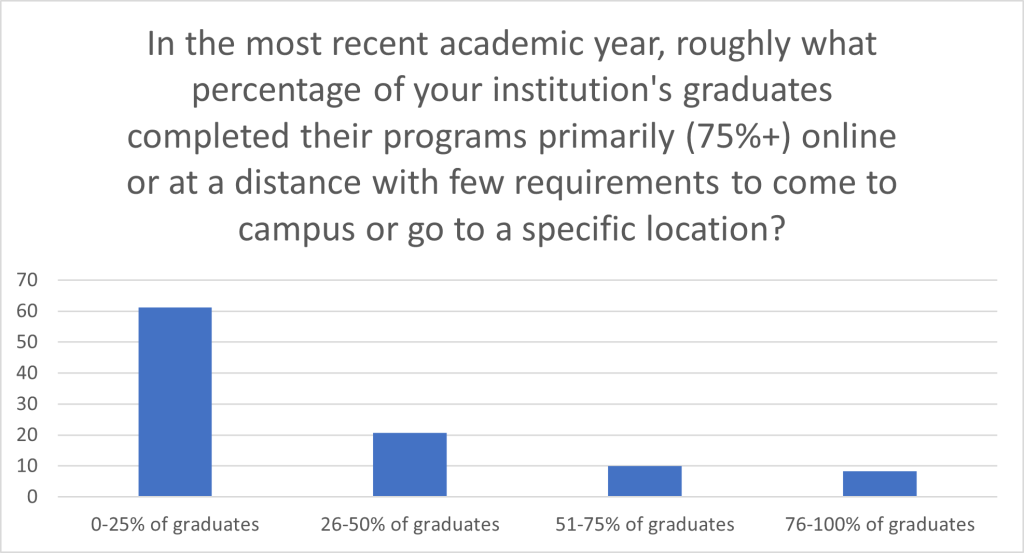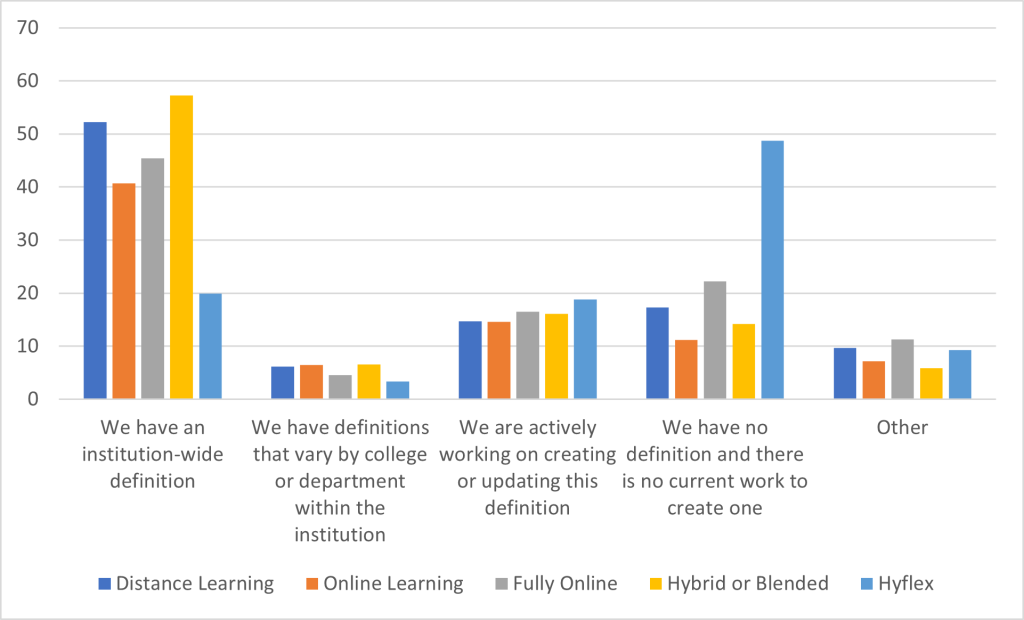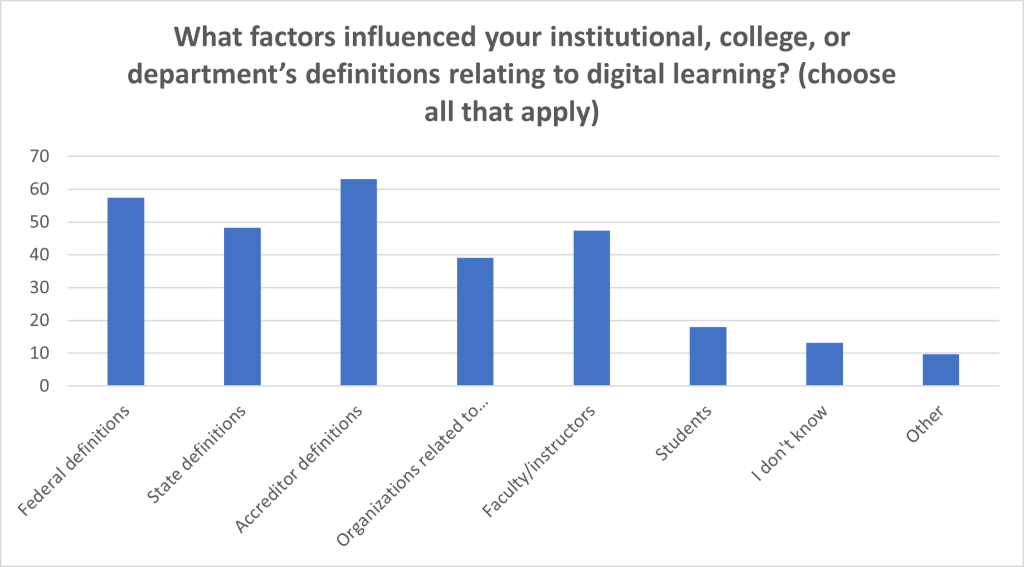This is the second of our two-part blog post series on the recently released U.S. Department of Education regulations. The first covered new rules regarding programs leading to professional licensure. This one is about institutions complying with closure requirements in each state in which it serves students. We, especially, analyze the impact on the more than 2,000 institutions that serve students through the State Authorization Reciprocity Agreement (SARA).
The U.S. Department of Education (the Department) formally announced the new federal regulations that impact institutions serving students in programs leading to a license or certification and created new institutional closure requirements, which may have an impact on state authorization reciprocity. The Federal Register October 31, 2023 announcement of Financial Responsibility, Administrative Capability, Certification Procedures, Ability to Benefit (ATB) includes the release of the remaining four issues related to the Winter 2022 rulemaking, Institutional and Programmatic Eligibility Committee.
It is the Certification Procedures issue that we followed closely and reported on often during the three months of rulemaking committee meetings and summarized the outcome of the committee soon thereafter. Of utmost concern was that sub-issues of Professional Licensure and Closure/State Authorization that were not announced, but were inserted by negotiators within the Certification Procedures issue without the opportunity to nominate knowledgeable committee members to share invaluable and pertinent information for the committee’s discussions.
This entire package of regulations was released as final on October 31, as well as the Final Regulations for Financial Value Transparency & Gainful Employment released on October 10, 2023. These regulations become effective July 1, 2024.
Introduction
Note to the reader: This introduction is mostly repeated from the first post.
The Certification Procedures issue focuses on the agreement between postsecondary institutions and the Department that each institution certifies compliance with specific obligations in order to participate in Title IV HEA Programs. The agreement is called a Program Participation Agreement (PPA). The Department’s goal was to strengthen student protections within the PPA. The sub-issues for which we followed were among the new requirements being added to the PPA even though there are Federal regulations that direct institution requirements in these two areas.
You may recall that, when the proposed regulations were released in May 2023, we provided two separate WCET Frontiers posts to share our analysis. Our first post addressed the regulation subsection that appears to require that institutions comply with state consumer protection laws for closure, recruitment, and misrepresentation where the institution is located and where the student is located at time of initial enrollment. The second post addressed the institution’s responsibility to satisfy applicable educational prerequisites where the institution is located and where the student is located at the time of initial enrollment as well as an edit to the currently effective public notification requirements.
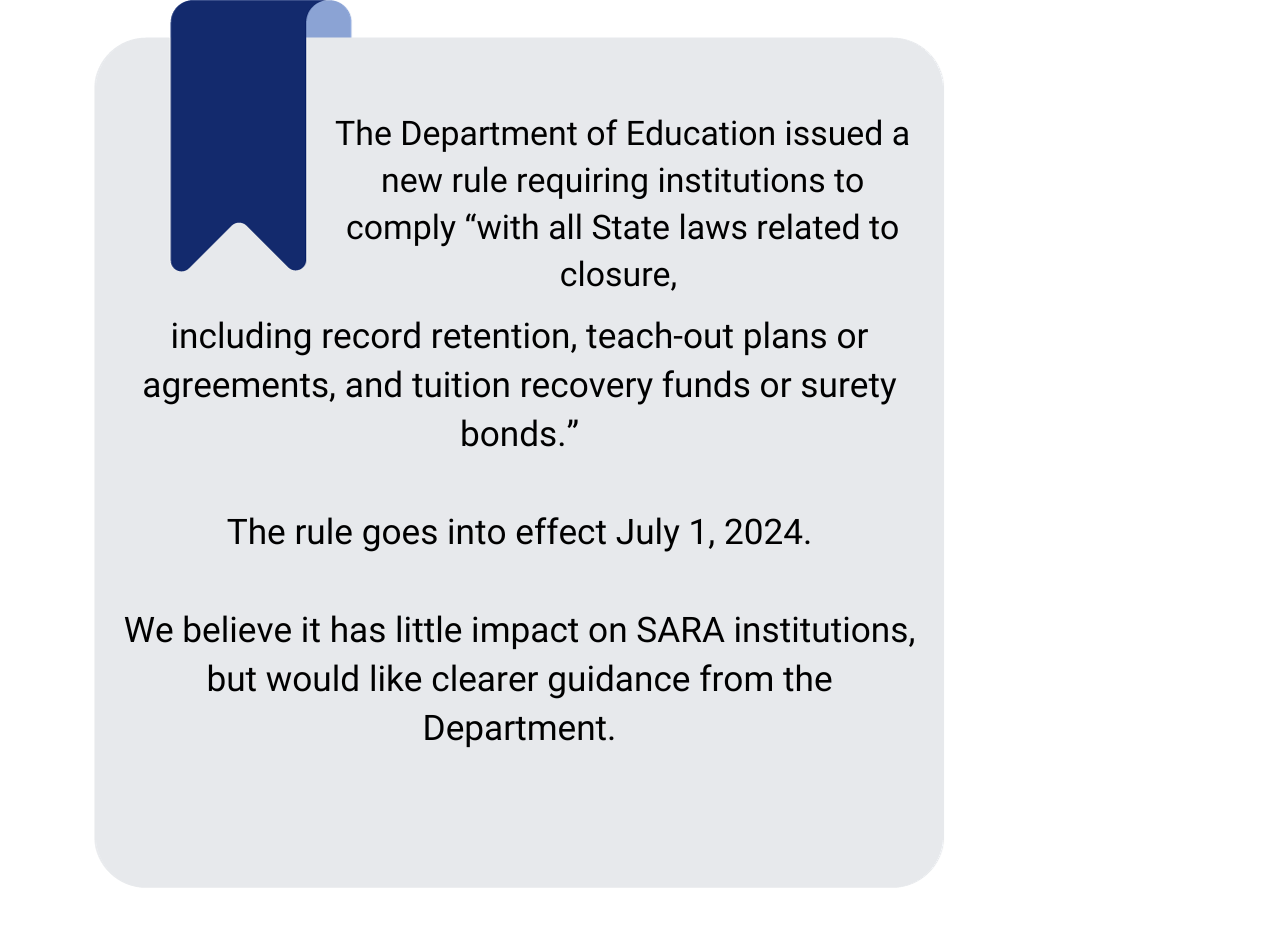
The final regulations released have been modified to some degree from the proposed regulations. We believe that the public comments that we all shared with the Department were heard and persuaded the Department to make some changes to the final language. However, we believe there appears to still be some misunderstanding by the Department about the variation of oversight for licensed professions by state and by the specific profession. Additionally, there are lingering questions about the applicability of state consumer protection laws upon institutions that participate in reciprocity.
Please consider sharing your questions with the Department on these areas, especially regarding the challenges of coordination of processes and information with state licensing boards. The Federal Register announcement includes the contact information for the Department staff member addressing this issue. For certification procedures: Vanessa Gomez. Telephone: (202) 987-0378. Email: Vanessa.Gomez@ed.gov.
This is the second of our two posts reviewing the new requirements around state closure laws and the impact and interstate reciprocity agreements, such as SARA. Look for our first post New Federal Regulations, Part 1: Addressing Programs Leading to a Licensure or Certification.
In both posts we will ask the following questions:
- What does the final regulation say?
- What questions and comments did WCET and SAN share with the Department during rulemaking, public comment period, and the Office of Management & Budget final review (EO 12866 Meeting)?
- How did the Department respond to WCET and SAN’s questions in the preamble of the final regulations?
- What are the implications to the institution for implementation of the regulations?
*Please note that page numbers in the analysis will refer to the unofficial version of the rules released on October 24 as that document is larger print and easier to direct you to the language of the preamble and regulations.
Final Regulations Addressing State Consumer Protection Laws (Affects State Authorization and Reciprocity)
Certification Procedures — 34 CFR 668.14(b)(32)(iii)
What does the final regulation say?
(32) In each State in which: the institution is located; students enrolled by the institution in distance education or correspondence courses are located, as determined at the time of initial enrollment in accordance with 34 CFR 600.9(c)(2); or for the purposes of paragraphs (b)(32)(i) and (ii) of this section, each student who enrolls in a program on or after July 1, 2024, and attests that they intend to seek employment, the institution must determine that each program eligible for title IV, HEA program funds…
(iii) Complies with all State laws related to closure, including record retention, teach-out plans or agreements, and tuition recovery funds or surety bonds…
What questions and comments did WCET and SAN share with the Department during rulemaking and the public comment period?
During rulemaking.
In the announcement for this rulemaking and the call for negotiators, there was no mention of consideration of rules related to state authorization. Just prior to the second session, we were surprised that a few negotiators proposed requirements for institutions regarding the assurance that they abide by all state “consumer protection” laws. While these proposed rules were not explicitly aimed at the State Authorization Reciprocity Agreement (SARA), it was clear by the proposers, the context, and the brief discussion that the intent was to implement regulations that would have a dramatic effect on SARA. During the second of three sessions in February 2022, the negotiator for the Department pushed back on the introduction of new issues to be considered. Typically, it is against rulemaking protocol to introduce new issues after the agenda is set in the first session. Although it was unclear if it would go forward, we wrote the blog post linked above and reached out to negotiators (including holding calls with some of them) about the possible impact of the proposed language. For the third session, the Department provided its own version of the proposed rule. Nobody liked it and it failed to reach consensus. After the meeting, we wrote about our reactions to the proposal.
Public Comment.
When it released its proposed rules for comment in May 2023, the Department tried to limit the impact of the “state consumer protection laws” to only those laws related to closure, recruitment, and misrepresentations. As a result, institutions participating in reciprocity would also need to comply with those rules in each state. Unfortunately, those terms were not defined.
WCET and SAN submitted a public comment focused specifically on the impact on reciprocity for proposed “state consumer protection laws related to closure, recruitment, and misrepresentations. Our main recommendations to the Department were:
- Withdraw the Proposal and Rely on the Department’s Upcoming Negotiated Rulemaking. Since the issue was discussed only briefly, we believe that this “complex topic “deserves full consideration with a more complete slate of negotiators knowledgeable of the issues and impact of proposed actions.
- Support a Process to Protect ALL Students. The proposal would result in changes in only a few states. Why not work with SARA to protect all students?
- As a Last Resort: Narrow and Sharply Define the Language. “If the Department moves forward, we recommend changing the wording to focus on a limited set of narrowly targeted and well-defined consumer protections.”
We provide a detailed review of the Department’s analysis in our public comment, and included a major concern that the Department was usurping the will of 49 states, the District of Columbia, Puerto Rico, and the Virgin Islands in joining the State Authorization Reciprocity Agreement (SARA). Additionally, we were quite concerned at the late introduction of the topic, the lack of experienced negotiators, and the lack of analysis on the problem to be solved and the impact of the proposed regulations.
Four clarifying questions were posed to the Department related to the proposed language of 34 CFR 668.14(b)(32)(iii):
- If the PPA indicates that for purposes of program eligibility the institution’s responsibility is specified “at the time of initial enrollment,” what are the responsibilities if the student changes location?
- How does the Department intend to reconcile the inconsistencies in proposed language with the current regulations defining a state authorization reciprocity agreement?
- How does the Department intend to be aware of, train, and enforce compliance with meeting varied state consumer protection laws related to closure, recruitment, and misrepresentation?
- What is considered evidence of compliance that the institution has Determined that it Complies with these state consumer protection laws?
Office of Management & Budget (OMB) final review (EO 12866 Meeting).
WCET & SAN provided testimony to the OMB/OIRA meeting, which is the final review prior to the Department’s release of final regulations. We shared our concerns related to federalism as we believe that the Department is creating barriers that overstep the state’s rights to create regulations and decisions to how students are served in their states.
Although we had heard that the review panel rarely asks questions, we were pleasantly surprised that the panel asked many questions and remarked upon the specificity of the issues of concern that we raised.
How did the Department respond to WCET and SAN’s questions in the preamble of the final regulations?
First, a general comment: In its overall response, the Department consistently confused SARA (the State Authorization Reciprocity Agreement) with NC-SARA (the National Council that runs SARA in partnership with the four regional higher education compacts). This is a very important distinction and goes well beyond a nuance. SARA is an interstate agreement with policies regarding how states and institutions will act within that agreement. NC-SARA is an office with great people facilitating collaboration among the compacts to implement reciprocity among member states. SARA critics will often cite NC-SARA as a method to discredit reciprocity as an entity imposing oversight as an effort done “to” states and not an effort conducted “by” states.
- Regarding the lack of state authorization expertise on the panel and that this issue should have been postponed to the announced future rulemaking (pages 26-27). The Department made this important statement (underlining added):
“The provisions in question are not a negotiation around the regulatory sections that include State authorization or distance education. We did not regulate the conditions, structure, or other elements of State reciprocity agreements or the organizations that operate them, nor did we set requirements that States must follow to oversee institutions enrolling students in a State where they have no physical presence.”
Regarding their new closure requirements, they made this important statement:
“The extent to which States have these laws, what they require, and to whom they apply them to is up to the States.”
On future rulemaking, they promised:
“The Department will consider broader issues related to distance education and State authorization in future rulemaking efforts, during which we will consider the need for representation such as what the commenters requested.”
Relatedly, to a response from another commenter who sought to put more requirements on reciprocity agreements (p. 403): “Many of the issues raised by the commenter get at broader questions of State authorization and reciprocity, which we think are better addressed in a future regulatory package.” - Regarding the lack of authorization experience of negotiators, the flawed process of introducing the proposal during rulemaking, and the extremely limited time set aside for discussing it (pages 371-374). The Department disagreed, saying that the negotiators had the proper qualifications and disagreed that the issue was not discussed.
- Regarding the previously proposed language to require institutions to comply with all state misrepresentation laws (pages 403-404). We were among the commenters who said that “State attorneys general are already authorized to act upon misrepresentation claims that institutions have against them.” The Department was persuaded and removed misrepresentation from the final language.
- Regarding the ambiguity of the previously proposed language regarding “closure, recruitment, and misrepresentation (pages 404-406). In our comment, we asked who would define these terms (the Department, states, other?) and that there will be different interpretations. We suggested that the “requirements should be as common as possible across all states to assure consistent protections regardless of the location of the student. For example, “state consumer protection” laws for “closure” could include tuition recovery funds, surety bonds, catastrophic event plans, teach-out processes, records retention, and more.”
The Department agreed, saying: “We have revised § 668.14(b)(32)(iii) to read “Complies with all State laws related to closure, including record retention, teach-out plans or agreements, and tuition recovery funds or surety bonds.” While others had similar comments, we noted the final product closely tracked with our proposal. - Regarding whether institutions participating in reciprocity have to follow the closure requirements of each state. From another commenter, they recommended that the Department “clarify that institutions that are authorized to operate in multiple States pursuant to a reciprocity agreement must follow all generally applicable State laws and those education-specific State laws that relate to closure, recruitment, and misrepresentations.” Remember they were commenting when the Department had all three of those provisions and had not, yet, limited it to just closure.
The Department responded (underlining added): “Institutions can and should be subject to laws beyond the specific types that institutions are certifying to us. That includes generally applicable State laws and what other laws specific to postsecondary education that apply for institutions that do or do not participate in a reciprocity agreement.” We are not sure that clarified the issue. - Regarding the rules negating the benefits of interstate reciprocity (pages 409-412). “Many commenters asserted that the requirement to observe individual States’ consumer protection laws pertaining to closure, recruitment, and misrepresentations, including both generally applicable State laws and those specific to educational institutions, will eliminate most or all of the advantage that derives from subscribing to NC-SARA (sic).”
In response, the Department disagreed (underlining added): “Institutions will still have the many benefits that such agreements offer, including reduced burden and fees. States are a key part of the regulatory triad of postsecondary education. We believe that if States wish to create laws to protect their students from closure, they should be able to do so. This language preserves State flexibility on how they wish to write their laws.” - Regarding the increased burden on state regulatory agencies (412-413). In reply, the Department said: “The Department believes limiting this provision to only closure and spelling out specific areas underneath it addresses the concerns of commenters. Moreover, the extent to which these closure provisions apply to out-of-State schools will depend on underlying State law.”
- Regarding the fact that states joined SARA voluntarily and that SARA’s policies were not “imposed” on them as asserted in a letter from Attorneys General and comments from other critics of reciprocity (pages 416-417). Our comment was cited as saying “that State attorneys general are only one entity” within state government. The commenter further noted that “all States except California have chosen to enter NC-SARA, which in most cases involved a bill passed by State legislature and signed by the governor voluntarily.” The Department gave this somewhat off-the-mark response, that it “is not telling States how to structure their laws related to closure. We are requiring institutions to certify to us that they are complying with all laws related to closure in the States where they operate. This is critical because we are concerned about the disruptions and costs associated with closure.”
- Regarding our suggestion that the Department work more closely with states, regional compacts, and consumer groups on reciprocity (pages 418-419). The Department says: “We will continue to identify opportunities to improve joint oversight of institutions of higher education.”
- Regarding our request that the Department harmonize their proposed language with the definition of a “state authorization reciprocity agreement (page 419). The Department disagreed saying: “This regulation concerns what institutions will certify to the Department.”
- Regarding if this regulation applies to institutions participating in reciprocity (page 420). One commenter wanted “to know if the Department means to say that if a State’s consumer protection laws explicitly state that they apply only to institutions operating with a physical presence in the State, an institution operating under a reciprocity agreement without a physical presence should not be required to comply with a law from which it is exempt.”
The Department’s response (underlining added): “Institutions would have to affirm they are complying with those applicable and relevant State laws. For instance, if a State’s tuition recovery fund law exempts out-of-State institutions, those institution (sic) would not have to abide by it.” - Regarding another question about whether this applies to institutions participating in reciprocity (pages 422-424). The Department’s response (underlining added): “…this language specifically requires that institutions certify that they comply with relevant State laws related to the closure of institutions of higher education…Institutions would have to provide this certification regardless of whether they participate in a reciprocity agreement.”
What are the implications to the institution for implementation of the regulations?
In short, this is unclear.
That is even after the Department tried to answer the question multiple times in their response. See items 5, 11, and 12 above.

Before getting to the details, we thank the Department for the important instances when they considered our recommendations and commented on them. Limiting their new regulation only to the four sets of state laws related to institutional closure (record retention, teach-out plans or agreements, tuition recovery funds, and surety bonds) makes sense. SARA leadership should consider adding these elements into their student protections.
On the other hand, the Department sometimes dismissed real concerns out-of-hand. Their unwillingness to learn about the operations of state regulatory agencies is a bit worrisome.
The big question remains, will institutions need to meet each state’s closure requirements even if they participate in reciprocity? To be clear, ALL institutions are subject to this new rule whether they participate in reciprocity or not. This all hinges on whether the Department finds that the reciprocity agreement’s provisions, as agreed to by each member state, meet the new requirement.
- On the “Yes, institutions WILL need to meet each state’s closure requirements separately even if they participate in reciprocity” side…
- The original proposed language submitted prior to rulemaking session #2 in 2022 was much broader and specifically targeted reciprocity agreements. As proposed, the only remaining benefits for reciprocity would be “to submit an application to state authorizing agencies or pay a fee to a state authorizing agency.”
- In items 12 in the previous section, note that the Department said (underlining added): “Institutions would have to provide this certification regardless of whether they participate in a reciprocity agreement.”
- Since the release of the final regulation, one of the negotiators who made that proposal during rulemaking wrote a blog post saying that: “The amendments to the Certification Procedures rule require institutions that operate in multiple states pursuant to a reciprocity agreement to determine that each program complies with state consumer protection laws related to closure in each state where the program is offered.”
- On the “No, institutions WILL NOT need to meet each state’s closure requirements if they participate in reciprocity, as participating in reciprocity includes an explicit list of requirements used by that state on out-of-state institutions” side…
- In item #1 above, the Department said: “We did not regulate the conditions, structure, or other elements of State reciprocity agreements or the organizations that operate them, nor did we set requirements that States must follow to oversee institutions enrolling students in a State where they have no physical presence.”In fact, all mention of reciprocity is removed from the final language.In responding to a query about whether this requirement applies to institutions participating in reciprocity, the Department said (underlining added): “…if a State’s tuition recovery fund law exempts out-of-State institutions, those institution (sic) would not have to abide by it.” Most states participating in SARA have specific carve-outs in their legislation or enabling language that provides this exemption for out-of-state institutions authorized by a member SARA state.
- In addition to limited authority over SARA participating institutions, many states limit their authority over out-of-state institutions without physical presence, noting that in some states authority is sector specific.
Ok. So that’s confusing.
The bottom line is that, among the two camps, we lean toward the “No” argument. The Department tripped over itself in being clear that it was not regulating reciprocity, it was relying on state laws, and that the terms of reciprocity are to be negotiated in the rulemaking that is tentatively planned for early next year.
Do we agree with the SARA critics that improvements are needed in protections for interstate distance education students? We do, but we think it can be best accomplished through SARA to improve protections nationally in the 52 states and territories not just in states that have applicable rules. Additionally, we do not agree with all the suggestions of SARA critics. The SARA community needs to do more in the coming year and addressing closure requirements is a good start.
We have run into other situations in the past where the Department’s wording did not match its intent. We will ask the Department for clarification, and you should too. See “Next Steps” below on how to request that clarification from them.
Conclusion and What Institutions Should Do
Please remember that this is our early analysis of the new final regulations addressing the new closure requirements and the impact on state reciprocity agreements. For institutions, addressing closure requirements appears to have a lesser impact on their additional work than was found for the professional licensure requirements.
All institutions will be subject to this new requirement, regardless of if they participate in reciprocity or not. As previously suggested in the post for programs leading professional licensure, institutions should review and revise their institution process to determine the location of the student at the time of initial enrollment as has been required since July 1, 2020.
The question remains as to “will institutions need to meet each state’s closure requirements even if they participate in reciprocity?” Either way, we expect pushback:
- If the answer is “Yes” – there are likely to be lawsuits and pushback from states. The National Council of State Legislatures opines on issues only if three-quarters of the states agree. They opposed this regulation, which means both red and blue states agreed.
- If the answer is “No” – the SARA critics and supporters of the Department of Education will be upset. They will push for much stricter regulation of reciprocity in upcoming rulemaking. There may be individual states that might try to take their own actions. We will be watching and sharing on the SAN website when/if individual states determine their authority to impose specific state closure laws on institutions participating in reciprocity through SARA.
In any case, there are only a few states that have closure requirements for out-of-state institutions. Watch for more updates from us on this issue. Meanwhile, a “quick chart” on state-by-state rules can be found on the State Authorization Network (SAN) website. Watch for applicable closure laws to be added to the chart soon.
Remember that ALL institutions are subject to this new rule. For institutions:
- If your institution is not participating in reciprocity, you should make sure that you are meeting the closure requirements in each state in which you are enrolling students who will obtain Title IV financial aid.
- If your institution is participating in reciprocity, you should:
- Check the State Authorization Network “quick chart” on its website and watch for updated state-by-state analyses of requirements in the few states that have them. Check your enrollment in those states.
- Until we receive clarification from the Department, judge your sense of the answer to the question regarding if reciprocity meets the requirement and the risk you wish to take. We believe SARA’s provisions meet the Department’s intent, but we are not the official word. We cannot give you legal advice.
Next Steps
These conclusions come from our early analysis. We still have questions and we’re sure you do too. SAN and WCET will be seeking your input to learn your lingering questions. We maintain that by working together we will develop implementation strategies. SAN is already in process the of reaching out to national associations for licensing boards to inform them of the final regulations. We will also collaborate with NASASPS and the SARA Community to ensure that applicable information is shared. Additionally, we urge you to follow the Federal Register announcement direction to seek more information from the Department staff member addressing this issue. For certification procedures: Vanessa Gomez. Telephone: (202) 987-0378. Email: Vanessa.Gomez@ed.gov .
Look to SAN and WCET for more on these issues in the coming weeks!
Get additional updates, summaries, and analysis of these issues and many more in our upcoming SAN and WCET member-only webcast: “Waze” to Find the Detours and Fast Lanes to Understand New U.S. Department of Education Guidance and Regulations.

